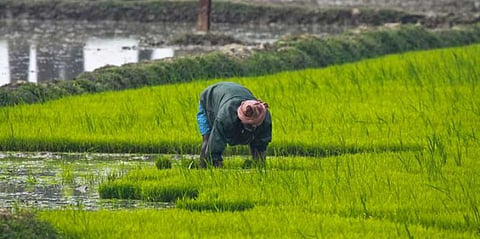
- Home
- Live Blog
- Breaking News
- Top Headlines
- Cities
- NE News
- Sentinel Media
- Sports
- Education
- Jobs

A scientific study revealing dual disaster risk of flood and drought for five Assam districts has also set off the alarm bells ringing on rising vulnerability of other districts due to climate change impact. The report of the study released by IIT, Guwahati, in collaboration with IIT, Mandi, and the Centre for Study of Science, Technology and Policy, Bengaluru, highlights that these five districts—Sivasagar, Dibrugarh, Charaideo, Golaghat, and South Salmara-Mankachar—are among 11 districts across the country that are at “very high” dual risk of disaster from flood and drought. The state government prioritising disaster risk prevention, mitigation, and reduction over relief and rehabilitation efforts post disaster can significantly moderate the climate risk profile of these districts. The report titled “District-Level Climate Risk Assessment for India: Mapping Flood and Drought Risks Using IPCC Framework” recommends a “multi-scale, sector-specific approach to climate risk assessment and continuous capacity building at the local and regional levels.” It underscores the need for forward-looking strategies to tackle compound and emerging climate risks effectively, according to an official release issued by IIT Guwahati Media Cell. Four of these five districts—Sivasagar, Dibrugarh, Charaideo, and Golaghat—being Assamese-majority, the dual risk has exacerbated the climate vulnerability of a large section of Assamese farmers in the state. Without adequate protection from such disaster risk, these Assamese farmers will be pushed to a vicious cycle of poverty and hunger, which will further aggravate their economic condition. Agrarian crisis arising from flood and drought risk will turn farming into a non-remunerative practice, which in turn may lead to distress selling of farmlands by downtrodden and marginalised Assamese farmers to the migrant business class and immigrant settlers. The conversion of large stretches of land along the highways in Assamese-majority areas is a pointer in that direction that must not be ignored by the Assamese society. Sadly, such changing socio-economic reality has failed to wake the Assamese people from deep slumber and motivate them to take a pledge to build community resilience against socio-economic hardship precipitated by increasing disaster risk. The fifth district with dual risk of flood and drought, South Salmara-Mankachar, has immigrant Muslims as the majority population, but they are known for their capability to build their economic resilience by migrating to different places in Assam, including upper Assam districts, to pick up menial jobs in the construction sector and every single livelihood opportunity when youth from marginalised Assamese farm families migrate outside the region to work as security guards or other unskilled workers. The vast difference between Assamese farmers and immigrant farmers in climate change adaptation does not bode well for the Assamese community in the long run, more particularly in the four Assamese-majority districts with very high dual disaster risk. Preventing the transfer or sale of land of Assamese farmers in these districts to non-Assamese communities is of paramount importance, as once land is gone and the demographic profile of landowners changes drastically, all other efforts, be they by the community or the government, for the preservation of Assamese culture and heritage will be reduced to an illusory exercise. Strong land laws aimed at preventing land transfer and proxy ownership are the urgent need of the hour. Market competitiveness under a neoliberal economy discourages such protectionism as it poses hurdles in the availability of adequate land for industrial projects and infrastructure development, which is essential to facilitate such industrial growth. Suitable provisions under land laws can be articulated to make land available for large industrial projects but not without ensuring that Assamese and indigenous communities retain their land ownership and made stakeholders. More importantly, members of the farm families acquiring skills for different trades is critical to building resilience against climate change risks. All such community efforts need to run parallel to initiatives by the government for climate adaptability and disaster risk prevention in the agriculture sector, like the introduction of flood- and drought-resilient varieties, water conservation including rainwater harvesting, reducing areas under rain-fed cultivation through increased irrigation coverage, increasing productivity, etc. Some of the traditional best practices prevalent among farmers can be adopted and mainstreamed into climate risk mitigation and adaptation after proper scientific validation. Knowledge gathered and data generated on disaster risks and climate change impact through scientific studies can be meaningful only when these are utilised to chart a clear roadmap for the future to reduce the risk and prevent disaster. This requires the adoption of an effective disaster management framework that lays emphasis on looking at building resilience beyond structural and engineered solutions. Informing the communities about the changing risk profile and impending disasters is essential to increase community preparedness instead of them becoming solely dependent on relief and rehabilitation measures by the government. The problem does not have standardised or uniform solutions but requires district-specific or perhaps even region-specific solutions within a district. Considering all aspects of the socio-economic condition of the local communities must be integral to policy planning on climate risk to increase overall community resilience.